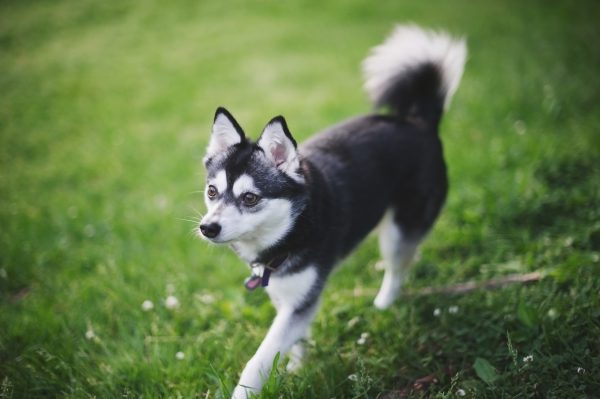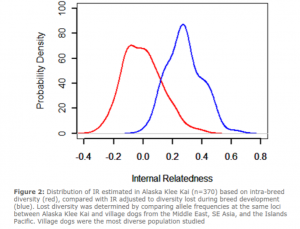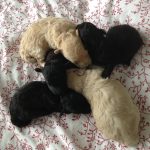
Alaskan Klee Kai
The Alaskan Klee Kai was developed in the 1970s by Linda Spurlin and her family in Alaska, who bred a rescue named Curious. It seems that the rescue had some Alaskan Husky and a small dog of unknown origin. Linda continued to select for the type and temperament of her crosses to develop today’s Alaskan Klee Kai. Reportedly, the Alaskan Klee Kai we have today was established from only 9 dogs, several Siberian and Alaskan Huskies, a Schipperke and an American Eskimo Dog. This establishes a very small initial genepool for this breed, but what did UC Davis Veterinary Genetics Laboratory and Dr. Niels Pedersen discover in the genetic analysis of the breed? Link to full report here.
Inbreeding – how closely related are the parents of the typical Alaskan Klee Kai?

Alaskan Klee Kai breeders have been doing a good job thus far selecting breeding mates that are as least
related to one another as possible within their small population. From the report:
The red line in figure 1 graphs the IR score for 370 individual AKK. The peak value for the population is around -0.1, with very few individuals having IR scores greater than 0.20. An IR score of 0.25 would be the mean value observed in a litter of puppies born to full sibling parents that came from a normal randomly breeding cross-section of dogs.
This is fantastic and means thus far AKK breeders have been outbreeding as much as possible within this population! We would recommend using our software to ensure this continues, as well as addressing the next concern: breed wide diversity.
Breed wide diversity
Biodiversity and allelic richness are words we try to discuss regularly at BetterBred. Namely, how many different versions of genes or alleles are there? The breeds with more allelic richness, that are also well distributed, tend to be healthier. What did they find about Alaskan Klee Kais?
From Dr. Pedersen’s report:
The bulk of the 370 dogs cluster around the intersection of the two coordinates, with relative few genetic outliers. This indicates that most individuals in the breed are closely related. The tightness of the cluster is somewhat unusual, given the phenotypic diversity of the breed. This indicates that the genes responsible for differences in
the phenotype are widely distributed within and between individual AKK.
What does this mean? This population has very little diversity to work with at this point, which is not atypical for other breeds that had small numbers of founders. It appears however that the breeders in this population have done a good job maintaining what they have, because of two other numbers we discuss often in videos but will point out here: namely average alleles per locus and average effective alleles per locus. The closer the effective alleles (we call these “alleles that are effectively contributing to your population”) are to the average alleles, the better distributed the breed. In the report, 4.788 average total alleles (updated on our website since the report was issued- 5.03 average alleles) per locus and 2.62 effective alleles per locus were found. Comparatively to other breeds, this is a very low average total alleles. However, the effective alleles being so close to the average means this population has done a good job maintaining what they have currently.
Because there is so little diversity, it is vital to maintain what this population has, as it would be very easy to lose more through genetic drift.
Diversity compared to the Village Dogs
Dr. Pedersen’s hallmark comparison is to a population of village dogs that has a great amount of genetic diversity. They analyze the results per breed to estimate the diversity remaining in each breeding population.
The shift of the peak to the right in IRVD compared to IR values was pronounced and the bulk of AKK would now be considered products of full-sibling matings if they were village dogs. Therefore, it is obvious that the breed has lost considerable genetic diversity as they evolved from their village dog predecessors to modern day AKK. However, this loss of diversity is not dissimilar to other breeds with small founder populations, such as the Akita or breeds with small numbers and less phenotypic diversity such as the Black Russian Terrier.
Again, this finding demonstrates that this breed has little diversity as a whole, and should strive to maintain what it has.
DLA – a Look at the Immune system
Considering the low number of founders for this population, AKK have a decent amount of remaining DLA types, similar to other small founder populations like the Biewer and Akitas, but more than the Swedish Vallhunds. From Dr. Pedersen’s report, “We have identified 11 different STR-associated DLA Class I (Table 4) and 8 DLA Class II (Table 5) haplotypes among 365 AKK. All of these haplotypes are shared with other breeds of dogs.”
Three class 1 and class 2 DLA types represent the majority of the tested DLA types in the population. These are 1014, 1040, and 1062 and 2021, 2039 and 2043 respectively. Breeders should take note of the less common DLA haplotypes (which will be consistently inherited from generation to generation) and try to increase the frequency of the less common types.
Which are the least common DLA haplotypes? The following DLA types are uncommon in this population:
Class One: 1008, 1011, 1060, 1061, 1063, 1064, 1072 and 1113
Class Two: 2007, 2012, 2014, and 2042
Conclusion
From Dr. Pedersen’s report:
If avoiding homozygosity whenever possible, at either genomic STR loci or at DLA class II haplotypes, will reduce disease problems in the breed to acceptable levels, this would be the best possible outcome. However, if genetic diversity needs to be increased, AKK breeders would need to consider a careful program of outcrossing and backcrossing.
Why would Dr. Pedersen suggest the potential for an outcross? Reports on breed health have indicated several breed specific complex diseases, and this may be a symptom of the lack of biodiversity (diversity at the breedwide level) within this breed. However, if health is acceptable to the breeders in this breed, then they must strive to maintain the breedwide diversity they currently have, so as not to increase the incidence of breed specific diseases. Our powerful online software will help to both ensure unrelated mates, but also to maintain the existing allelic richness of the Alaskan Klee Kai. Consider adding your dog to our growing database here.

 Previous Post
Previous Post Next Post
Next Post


